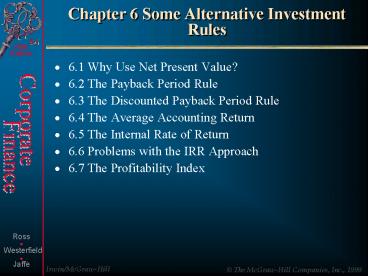Chapter 6 Some Alternative Investment Rules - PowerPoint PPT Presentation
1 / 9
Title:
Chapter 6 Some Alternative Investment Rules
Description:
Fifth Edition. Ross. Jaffe. Westerfield. 6-1. Chapter 6 Some ... May be useful when available investment funds are limited. Easy to understand and communicate ... – PowerPoint PPT presentation
Number of Views:90
Avg rating:3.0/5.0
Title: Chapter 6 Some Alternative Investment Rules
1
Chapter 6 Some Alternative Investment Rules
- 6.1 Why Use Net Present Value?
- 6.2 The Payback Period Rule
- 6.3 The Discounted Payback Period Rule
- 6.4 The Average Accounting Return
- 6.5 The Internal Rate of Return
- 6.6 Problems with the IRR Approach
- 6.7 The Profitability Index
2
Mutually Exclusive versus Independent Project
- Mutually Exclusive Projects only ONE of several
potential projects can be chosen, e.g. acquiring
an accounting system. - RANK all alternatives and select the best one.
- Independent Projects accepting or rejecting one
project does not affect the decision of the other
projects. - Must exceed a MINIMUM acceptance criteria.
3
The Net Present Value (NPV) Rule
- Net Present Value (NPV) Total PV of future CFs
Initial Investment - Estimating NPV
- 1. Estimate future cash flows how much? and
when? - 2. Estimate discount rate
- 3. Estimate initial costs
- Minimum Acceptance Criteria Accept if NPV gt 0
- Ranking Criteria Choose the highest NPV
4
Good Attributes of the NPV Rule
- 1. Uses cash flows
- 2. Uses ALL cash flows of the project
- 3. Discounts ALL cash flows properly
- Reinvestment assumption the NPV rule assumes
that all cash flows can be reinvested at the
discount rate.
5
The Payback Period Rule
- How long does it take the project to pay back
its initial investment? - Payback Period of years to recover initial
costs - Minimum Acceptance Criteria set by management
- Ranking Criteria set by management
6
The Payback Period Rule (continued)
- Disadvantages
- Ignores the time value of money
- Ignores CF after payback period
- Biased against long-term projects
- Payback period may not exist or multiple payback
periods - Requires an arbitrary acceptance criteria
- A project accepted based on the payback criteria
may not have a positive NPV - Advantages
- Easy to understand
- Biased toward liquidity
7
The Average Accounting Return (AAR) Rule
- AAR Average NI / Average Book Value of
Investment - Minimum Acceptance Criteria set by management
- Ranking Criteria set by management
- Disadvantages
- Ignores the time value of money
- Uses an arbitrary benchmark cutoff rate
- Based on book values, not cash flows and market
values - Advantages
- The accounting information is usually available
- Easy to calculate
8
The Internal Rate of Return (IRR) Rule
- IRR the discount that sets the NPV to zero
- Minimum Acceptance Criteria Accept if the IRR gt
required return - Ranking Criteria Select alternative with the
highest IRR - Reinvestment assumption the IRR calculation
assumes that all future cash flows are reinvested
at the IRR - Disadvantages
- Does not distinguish between investing and
financing - IRR may not exist or there may be multiple IRR
- Problems with mutually exclusive investments
- Advantages
- Easy to understand and communicate
9
The Profitability Index (PI) Rule
- PI Total Present Value of future CFs / Initial
Investment - Minimum Acceptance Criteria Accept if PI gt 1
- Ranking Criteria Select alternative with highest
PI - Disadvantages
- Problems with mutually exclusive investments
- Advantages
- May be useful when available investment funds are
limited - Easy to understand and communicate
- Correct decision when evaluating independent
projects































